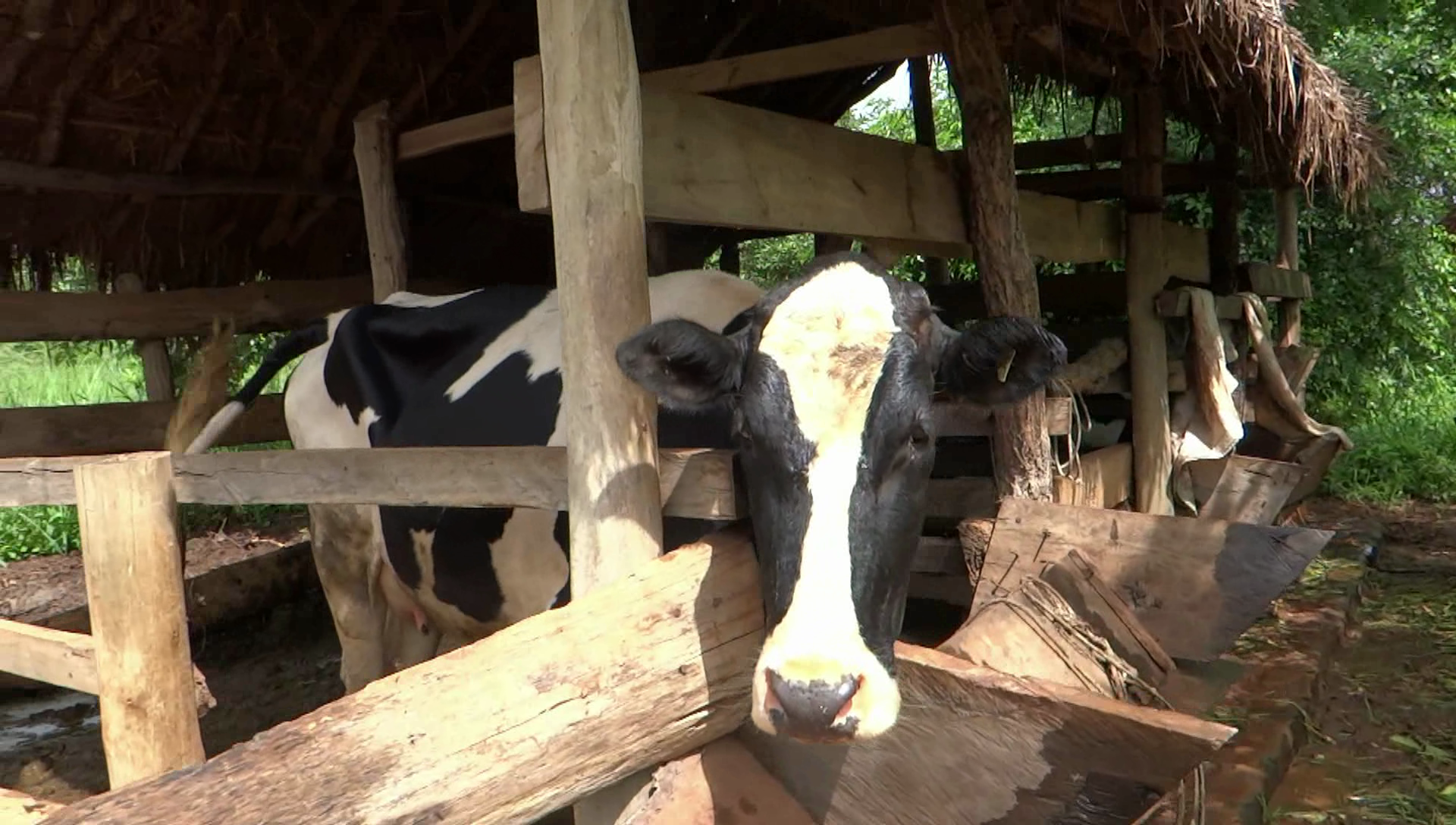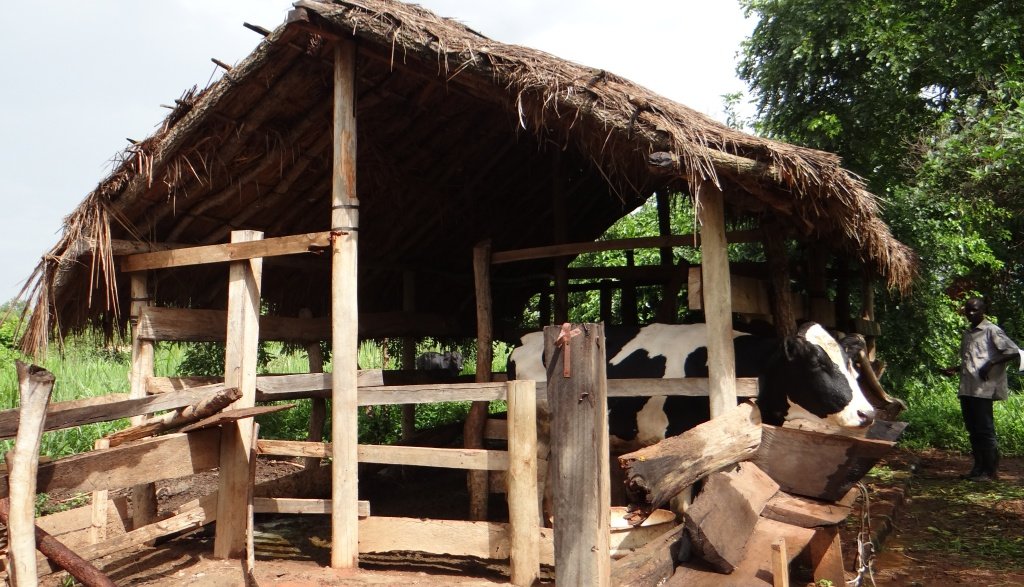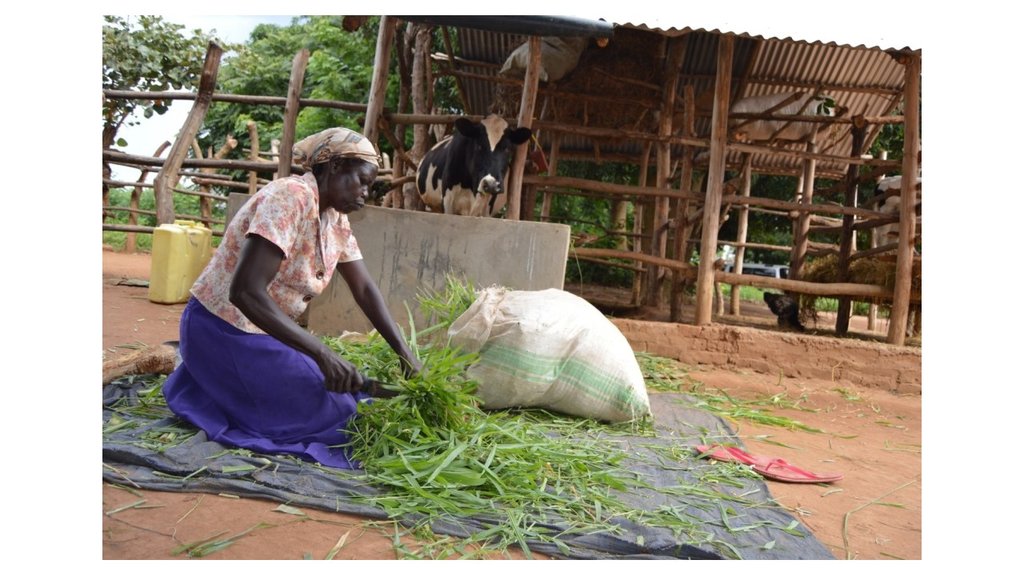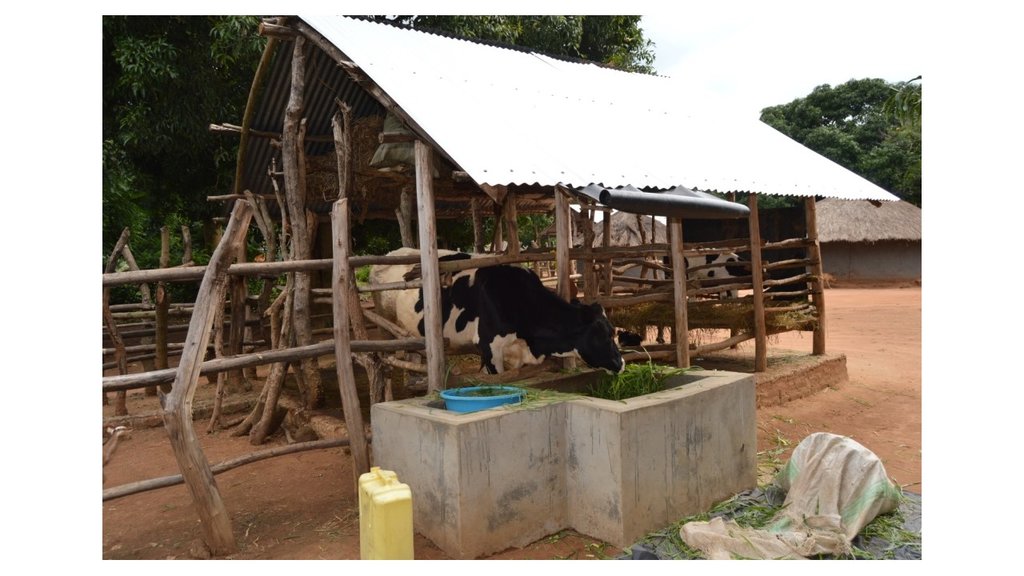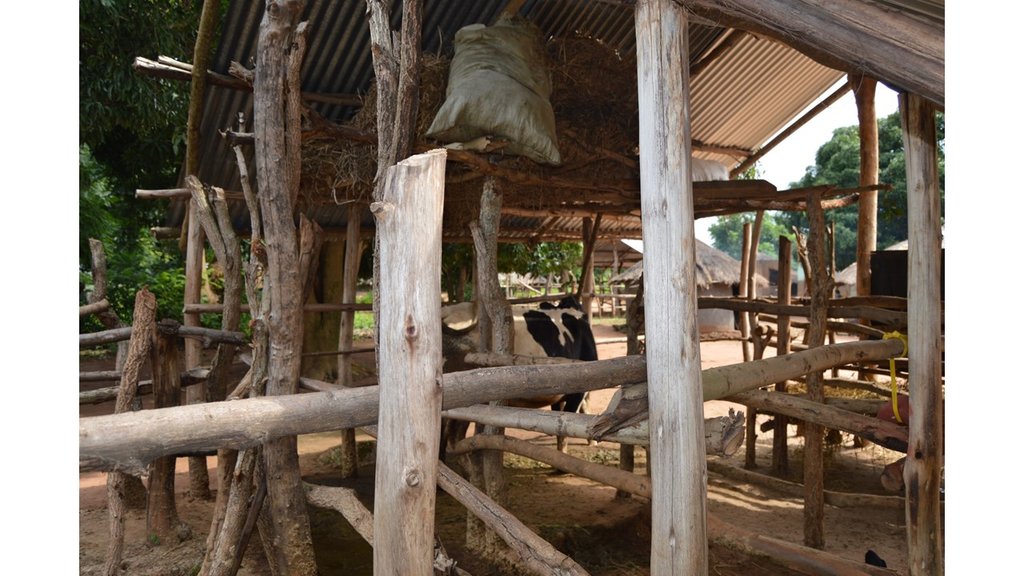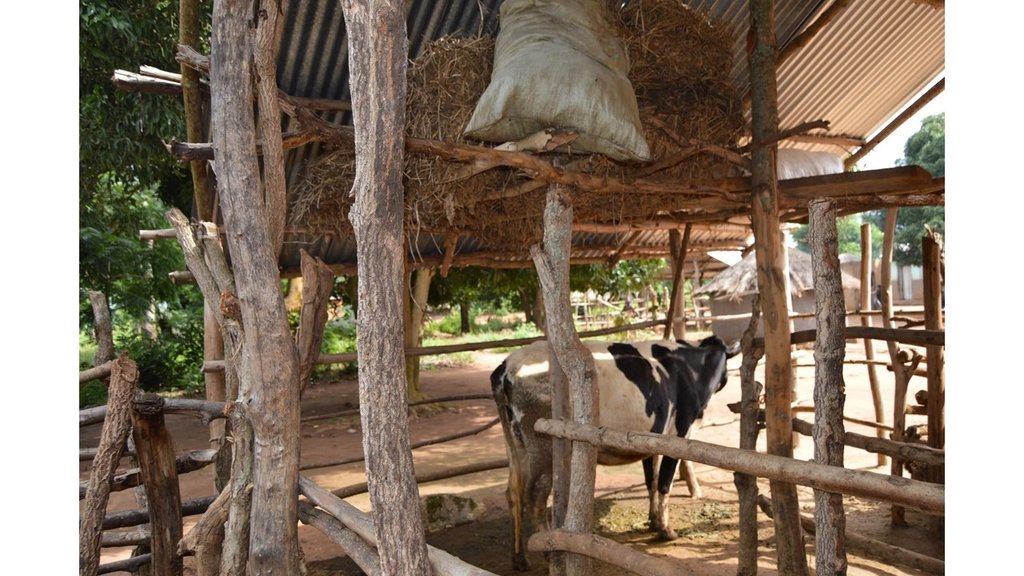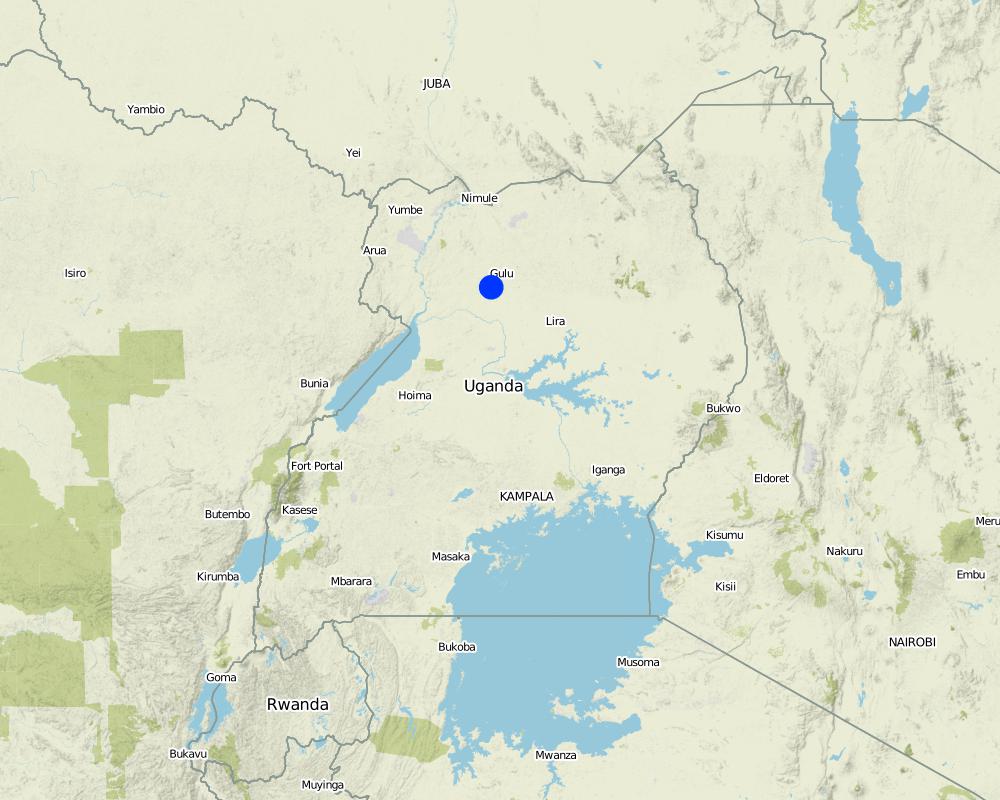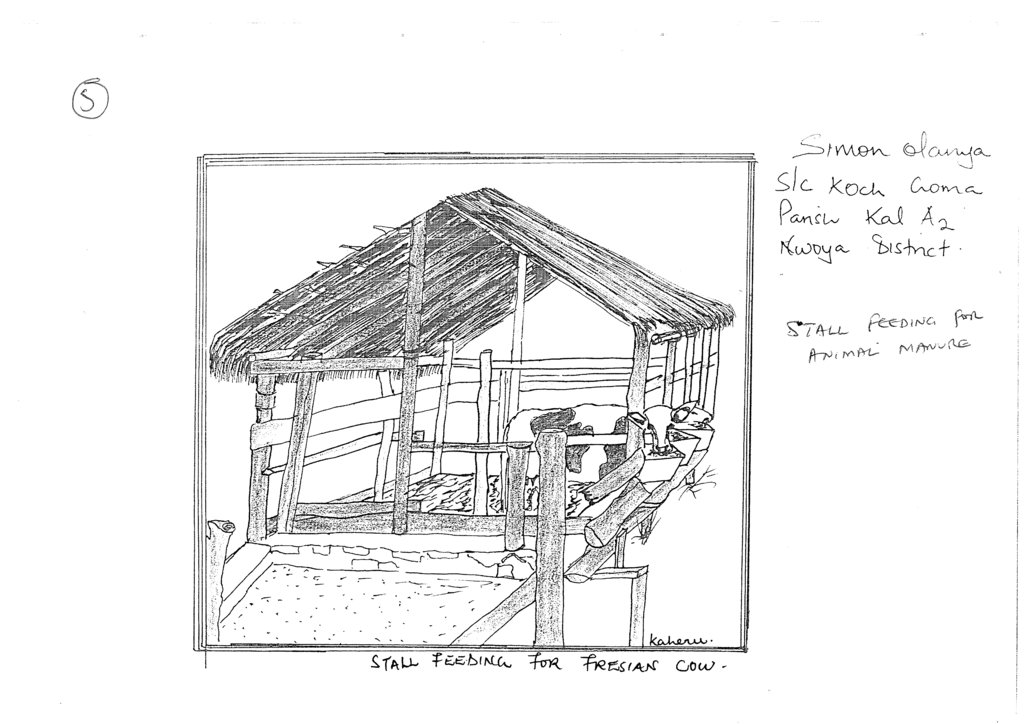Stall feeding of Friesian cow by cut and carry for livestock management [乌干达]
- 创建:
- 更新:
- 编制者: Kamugisha Rick Nelson
- 编辑者: Bernard Fungo, Richard Otto Kawawa, Sunday Balla Amale, JOY TUKAHIRWA
- 审查者: Rima Mekdaschi Studer, Stephanie Jaquet, Renate Fleiner, Nicole Harari, John Stephen Tenywa, Donia Mühlematter, Alexandra Gavilano
Gokwo dyang
technologies_2816 - 乌干达
- Stall feeding of Friesian cow by cut and carry for livestock management: July 16, 2018 (inactive)
- Stall feeding of Friesian cow by cut and carry for livestock management: March 22, 2019 (inactive)
- Stall feeding of Friesian cow by cut and carry for livestock management: Aug. 22, 2019 (public)
- Stall feeding of Friesian cow by cut and carry for livestock management: June 14, 2018 (inactive)
- Stall feeding of Friesian cow for manure: May 22, 2018 (inactive)
查看章节
全部展开 全部收起1. 一般信息
1.2 参与该技术评估和文件编制的资源人员和机构的联系方式
关键资源人
土地使用者:
Olanya Simon
Farmer
乌干达
乌干达
有助于对技术进行记录/评估的项目名称(如相关)
Scaling-up SLM practices by smallholder farmers (IFAD)有助于对技术进行记录/评估的机构名称(如相关)
CDE Centre for Development and Environment (CDE Centre for Development and Environment) - 瑞士1.3 关于使用通过WOCAT记录的数据的条件
编制者和关键资源人员接受有关使用通过WOCAT记录数据的条件。:
是
1.4 所述技术的可持续性声明
这里所描述的技术在土地退化方面是否存在问题,导致无法被认为是一种可持续的土地管理技术?:
否
2. SLM技术的说明
2.1 技术简介
技术定义:
Zero grazing by cut and carry feeding. The cows do not graze but are confined inside the stall, feed and water is provided for the animals.
2.2 技术的详细说明
说明:
Due to land fragmentation and conflicts, traditional grazing systems where animals are reared in open grasslands is no longer feasible and sustainable since grassland is limited and stray animals would destroy neighboring crops. Now small holders with limited land but diversified livelihoods have to utilize the available land in full capacity and sustainable ways. For dairy farmers, stall feeding is an innovative and promising system.
In this practice, a Friesian cow and its calf are confined inside the built stall. The stall has four partitions. A Calf room, milking pallor, feeding and drinking area and sleeping room. Within the feeding area is placed a wooden box of width 0.5m, length 1.5m and height 0.3m; into which feed is put for the animal. A half drum that can hold 80 liters of water is also put inside the feeding area. Both the wooden feeder and half drum are raised to a height of 0.5 m above the ground surface to prevent contamination of the feed with dung and urine; and also ensure efficient feed intake.
The farmer cultivated 1 acre of Napier grass (elephant grass), which provides adequate feed for the demands of the cow (75-100 kg of fresh grass per day). The Napier grass is cut, chopped and put inside the wooden box, while water is fetched from the stream and put into the half drum.
Through this method, the animal movement is restricted. This reduces the exposure to parasites such as ticks, and contagious diseases such as East Coast Fever. This practice also reduces land conflicts that would be caused by stray animals destroying crops of neighbors. The animal does not waste energy to look for pasture and water, hence milk productivity is enhanced. Manure is also deposited within the feeding area and thus easy to collect, decompose and apply in both farmers’ crop and pasture fields. Animals do not need to be attended to, hence farmer has more time to rest and carry out other activities.
However, a lot of labor is required for cutting and chopping the grass, and carrying the feeds and water especially during the dry season. Treatment of animals and maintenance of the stall is costly and if management is poor, parasites and diseases can also build up within the stall. Stall feeding requires feed preservation in the form of fermented pasture (silage) and/or dried pasture (hay); stored and to be used for feeding the animals during dry seasons when pasture is dry and of poor quality.
To sustain this technology, the land users can supplement the feed through cultivating multipurpose tree species (Calliandra spp and Grivellia spp), leguminous forages such as lablab spp and macuna beans. Non-conventional feeds such as kitchen wastes (cassava, sweet potato and banana peelings) can also supplement the cut and carried Napier grass.
2.3 技术照片
2.4 技术视频
注释、简短说明:
Video showing Stall feeding for fresian cow for animal manure
日期:
26/05/2017
位置:
Kosh village , Goma parish Unyona sub-county , Nwoya District
摄影师的名字:
Issa Aiga
2.5 已应用该技术的、本评估所涵盖的国家/地区/地点
国家:
乌干达
区域/州/省:
Northern Region,Uganda
具体说明该技术的分布:
- 均匀地分布在一个区域
如果不知道精确的区域,请注明大致覆盖的区域:
- < 0.1 平方千米(10 公顷)
注释:
Map showing the technology site in Northern Uganda
Barn, area where napier grass is planted, cut and carried.
Map
×2.6 实施日期
注明实施年份:
2014
如果不知道确切的年份,请说明大概的日期:
- 不到10年前(最近)
2.7 技术介绍
详细说明该技术是如何引入的:
- 通过项目/外部干预
3. SLM技术的分类
3.1 该技术的主要目的
- 创造有益的经济影响
- 创造有益的社会影响
3.2 应用该技术的当前土地利用类型

农田
- 一年一作
- 乔木与灌木的种植
- lablab spp and macuna bean
- Calliandra spp and Grivellia spp
每年的生长季节数:
- 2

牧场
集约放牧/饲料生产:
- 收割和携带/零放牧
动物类型:
- 牛 - 奶制品
- cow =1 . calf =1
- Fresian cow, milk production, manure and calf.
3.3 由于技术的实施,土地使用是否发生了变化?

农田
3.4 供水
该技术所应用土地的供水:
- 雨养
注释:
Use tap water from neighbour(brother) who pump under ground using generator.
Number of growing seasons per year:
2
3.5 该技术所属的SLM组
- 农畜综合管理
- 土壤肥力综合管理
- Stall feeding
3.6 包含该技术的可持续土地管理措施

农艺措施
- A2:有机质/土壤肥力

管理措施
- M1:改变土地使用类型
- M2:改变管理/强度级别

其它措施
注释:
Cut and carry
3.7 该技术强调的主要土地退化类型

化学性土壤退化
- Cn:肥力下降和有机质含量下降(非侵蚀所致)

物理性土壤退化
- Pc:压实
- Pu:由于其他活动而导致生物生产功能的丧失
3.8 防止、减少或恢复土地退化
具体数量名该技术与土地退化有关的目标:
- 减少土地退化
4. 技术规范、实施活动、投入和成本
4.1 该技术的技术图纸
技术规范(与技术图纸相关):
The stall should be 3 m tall, approximately with 4 rooms 1st floor for calf, second one for milking 3rd for sleeping and the 4th for feeding and drinking water.
The Inputs required for this technology include: concrete wall built with cement, , wood (makonko), grass or iron roof, wooden box of about 1.5x0.5 m, half drum of about 80 litres both raised at 50cm above the floor, rake , tauplin and polythene paper.
Slope: Gentle slope.
作者:
Kaheru
日期:
26/05/2017
4.2 有关投入和成本计算的一般信息
具体说明成本和投入是如何计算的:
- 每个技术区域
注明尺寸和面积单位:
1.5 acres
其它/国家货币(具体说明):
UGX
如相关,注明美元与当地货币的汇率(例如1美元=79.9巴西雷亚尔):1美元=:
3803.0
注明雇用劳工的每日平均工资成本:
5000
4.3 技术建立活动
| 活动 | 时间(季度) | |
|---|---|---|
| 1. | looking for land where to plant pasture | During the first rainy season |
| 2. | Looking for labour to clear the land, planting | Once in a year(April-June) |
| 3. | Looking for seed | once before establsihment |
| 4. | Planting the pasture | Daily after establishment |
| 5. | Initial construction of the stall | Once before establishment |
| 6. | Initial construction of of feeding and drinking troughs | Once before establishment |
| 7. | Putting the cow/s in the stall | Once after establishment |
| 8. | Feeding and watering | Daily |
4.4 技术建立所需要的费用和投入
| 对投入进行具体说明 | 单位 | 数量 | 单位成本 | 每项投入的总成本 | 土地使用者承担的成本% | |
|---|---|---|---|---|---|---|
| 劳动力 | labour for transporting wood and cement | Persons | 25.0 | 5000.0 | 125000.0 | 70.0 |
| 劳动力 | Labour for preparing and planting fields | Persons | 45.0 | 5000.0 | 225000.0 | 30.0 |
| 劳动力 | Labour for constructing stall | persons | 12.0 | |||
| 设备 | Hoe | Pieces | 2.0 | 10000.0 | 20000.0 | 100.0 |
| 设备 | Panga | Pieces | 1.0 | 7000.0 | 7000.0 | 100.0 |
| 设备 | Spranger | Pieces | 1.0 | 10000.0 | 10000.0 | 100.0 |
| 植物材料 | Elephant grass | bundles | 5.0 | 100000.0 | 500000.0 | 100.0 |
| 植物材料 | lab lab | Pieces | 4.0 | 5000.0 | 20000.0 | 100.0 |
| 植物材料 | Mucuna | Pieces | 1.0 | 20000.0 | 20000.0 | 100.0 |
| 施工材料 | Timber | Pieces | 40.0 | 3000.0 | 120000.0 | 100.0 |
| 施工材料 | Cement | bags | 10.0 | 30000.0 | 300000.0 | 100.0 |
| 施工材料 | Logs | Pieces | 60.0 | 3000.0 | 180000.0 | 100.0 |
| 施工材料 | Nails | kgs | 10.0 | 3500.0 | 35000.0 | 100.0 |
| 其它 | Grass to thatch the stall | bundles | 24.0 | 2000.0 | 48000.0 | 100.0 |
| 技术建立所需总成本 | 1610000.0 | |||||
| 技术建立总成本,美元 | 423.35 | |||||
注释:
Some seed like Macuna and brucheria was provided for free
4.5 维护/经常性活动
| 活动 | 时间/频率 | |
|---|---|---|
| 1. | Weeding pasture | Three times per year |
| 2. | Repairing of stall | once after establishment and when need |
| 3. | Treatment of cow | When need arises(sick) |
| 4. | Insemination | Once in two years |
| 5. | Spraying | Twice per week |
| 6. | Reseeding | During the rainy season |
| 7. | Replanting of pasture | During the rainy season |
| 8. | Cutting and carrying the grass to the animal | Daily after establishment |
| 9. | Collection of manure | Daily |
| 10. | Applying manure to the garden | Daily |
| 11. | Making silage and hay | During the wet season |
4.6 维护/经常性活动所需要的费用和投入(每年)
| 对投入进行具体说明 | 单位 | 数量 | 单位成本 | 每项投入的总成本 | 土地使用者承担的成本% | |
|---|---|---|---|---|---|---|
| 劳动力 | Labour on daily basis | Persons | 3.0 | 5000.0 | 15000.0 | 70.0 |
| 劳动力 | Hired labour on monthly basis | Persons | 2.0 | 150000.0 | 300000.0 | 30.0 |
| 设备 | Hoe | Pieces | 10.0 | 10000.0 | 100000.0 | 100.0 |
| 设备 | Rake | Pieces | 2.0 | 7000.0 | 14000.0 | 100.0 |
| 设备 | Tauplin | Pieces | 1.0 | 35000.0 | 35000.0 | 100.0 |
| 设备 | Polythene | Rolls | 1.0 | 25000.0 | 25000.0 | 100.0 |
| 植物材料 | pasture for planting | Bundles | 43.0 | 10000.0 | 430000.0 | 100.0 |
| 其它 | Pesticides (monthly) | litres | 2.0 | 12000.0 | 24000.0 | 100.0 |
| 技术维护所需总成本 | 943000.0 | |||||
| 技术维护总成本,美元 | 247.96 | |||||
4.7 影响成本的最重要因素
描述影响成本的最决定性因素:
Labour costs for establishing and maintaining the technology.
5. 自然和人文环境
5.1 气候
年降雨量
- < 250毫米
- 251-500毫米
- 501-750毫米
- 751-1,000毫米
- 1,001-1,500毫米
- 1,501-2,000毫米
- 2,001-3,000毫米
- 3,001-4,000毫米
- > 4,000毫米
指定年平均降雨量(若已知),单位为mm:
1500.00
有关降雨的规范/注释:
Two rainy season separated by about two weeks and dry spell and dry season of 4 weeks.
农业气候带
- 半湿润
5.2 地形
平均坡度:
- 水平(0-2%)
- 缓降(3-5%)
- 平缓(6-10%)
- 滚坡(11-15%)
- 崎岖(16-30%)
- 陡峭(31-60%)
- 非常陡峭(>60%)
地形:
- 高原/平原
- 山脊
- 山坡
- 山地斜坡
- 麓坡
- 谷底
垂直分布带:
- 0-100 m a.s.l.
- 101-500 m a.s.l.
- 501-1,000 m a.s.l.
- 1,001-1,500 m a.s.l.
- 1,501-2,000 m a.s.l.
- 2,001-2,500 m a.s.l.
- 2,501-3,000 m a.s.l.
- 3,001-4,000 m a.s.l.
- > 4,000 m a.s.l.
说明该技术是否专门应用于:
- 不相关
5.3 土壤
平均土层深度:
- 非常浅(0-20厘米)
- 浅(21-50厘米)
- 中等深度(51-80厘米)
- 深(81-120厘米)
- 非常深(> 120厘米)
土壤质地(表土):
- 中粒(壤土、粉土)
土壤质地(地表以下> 20厘米):
- 细粒/重质(粘土)
表土有机质:
- 中(1-3%)
5.4 水资源可用性和质量
地下水位表:
5-50米
地表水的可用性:
中等
水质(未处理):
良好饮用水
水的盐度有问题吗?:
否
该区域正在发生洪水吗?:
否
5.5 生物多样性
物种多样性:
- 低
栖息地多样性:
- 低
5.6 应用该技术的土地使用者的特征
定栖或游牧:
- 定栖的
生产系统的市场定位:
- 混合(生计/商业)
非农收入:
- 低于全部收入的10%
相对财富水平:
- 平均水平
个人或集体:
- 个人/家庭
机械化水平:
- 手工作业
性别:
- 女人
- 男人
土地使用者的年龄:
- 青年人
- 中年人
5.7 应用该技术的土地使用者使用的平均土地面积
- < 0.5 公顷
- 0.5-1 公顷
- 1-2 公顷
- 2-5公顷
- 5-15公顷
- 15-50公顷
- 50-100公顷
- 100-500公顷
- 500-1,000公顷
- 1,000-10,000公顷
- > 10,000公顷
这被认为是小规模、中规模还是大规模的(参照当地实际情况)?:
- 中等规模的
注释:
Inherited land
5.8 土地所有权、土地使用权和水使用权
土地所有权:
- 个人,未命名
土地使用权:
- 个人
用水权:
- 社区(有组织)
5.9 进入服务和基础设施的通道
健康:
- 贫瘠
- 适度的
- 好
教育:
- 贫瘠
- 适度的
- 好
技术援助:
- 贫瘠
- 适度的
- 好
就业(例如非农):
- 贫瘠
- 适度的
- 好
市场:
- 贫瘠
- 适度的
- 好
能源:
- 贫瘠
- 适度的
- 好
道路和交通:
- 贫瘠
- 适度的
- 好
饮用水和卫生设施:
- 贫瘠
- 适度的
- 好
金融服务:
- 贫瘠
- 适度的
- 好
6. 影响和结论性说明
6.1 该技术的现场影响
社会经济效应
生产
作物生产
注释/具体说明:
The area which is under pasture.
饲料生产
注释/具体说明:
0.5 acre improved pasture but lack management.
畜牧生产
SLM之前的数量:
3 litres of milk per day
SLM之后的数量:
10litres of milk per day
注释/具体说明:
Increased milk production.
生产区域
注释/具体说明:
Additional fodder.
土地管理
注释/具体说明:
Trees hold soils , are perennial as compared to annuals that need to be planted every year and need less maintenance.
水资源可用性和质量
家畜用水的质量
注释/具体说明:
But it has no much effect.
收入和成本
农业投入费用
注释/具体说明:
Planting material.
农业收入
注释/具体说明:
Sale of milk.
收入来源的多样性
注释/具体说明:
More products for sale (grass, milk, manure).
工作量
注释/具体说明:
Feeding animal.
社会文化影响
食品安全/自给自足
注释/具体说明:
Income received from sale of milk is used for buying food.
社区机构
注释/具体说明:
Especially in savings and credit (SACCO).
生态影响
土壤
土壤流失
注释/具体说明:
Restricted movements of cattle since the ve is only cut and carried to where the animal is fed.
土壤压实
注释/具体说明:
Less tampering with the soil.
土壤有机物/地下C
注释/具体说明:
Due to application of manure.
6.2 该技术的场外影响已经显现
对邻近农田的破坏
注释/具体说明:
No zero grazing.
温室气体的影响
注释/具体说明:
No bio gas production.
6.3 技术对渐变气候以及与气候相关的极端情况/灾害的暴露和敏感性(土地使用者认为的极端情况/灾害)
渐变气候
渐变气候
| 季节 | 增加或减少 | 该技术是如何应对的? | |
|---|---|---|---|
| 年温度 | 增加 | 适度 |
注释:
The land user requires more knowledge and skills for sustainability of this technology.
6.4 成本效益分析
技术收益与技术建立成本相比如何(从土地使用者的角度看)?
短期回报:
积极
长期回报:
非常积极
技术收益与技术维护成本/经常性成本相比如何(从土地使用者的角度看)?
短期回报:
积极
长期回报:
非常积极
注释:
Once established the farmer needs only to pay for labour to cut and carry grass and make silage and hay only.
6.5 技术采用
- 1-10%
在所有采用这项技术的人当中,有多少人是自发的,即未获得任何物质奖励/付款?:
- 0-10%
注释:
Motivated by NGO.
6.6 适应
最近是否对该技术进行了修改以适应不断变化的条件?:
是
若是,说明它适应了哪些变化的条件:
- 气候变化/极端气候
具体说明技术的适应性(设计、材料/品种等):
During the dry season, the land user seeks fodder from the swamps.
6.7 该技术的优点/长处/机会
| 土地使用者眼中的长处/优势/机会 |
|---|
| The technology is good at providing income for household needs. |
| The technology is replicable in other areas and helps diversify income source because of the many products derived from the technology. |
| Does not require labour to attend to it for 12 hours in a day unlike those technologies that concern cultivation. This means the farmer has more time to do other activities in a day. |
| 编制者或其他关键资源人员认为的长处/优势/机会 |
|---|
| Appropriate for low maintenance costs. |
| The technology does not promote conflicts among land users. |
6.8 技术的弱点/缺点/风险及其克服方法
| 土地使用者认为的弱点/缺点/风险 | 如何克服它们? |
|---|---|
| High costs of treatment. | Reduce risk of infection and infestation. |
| Veterinary services expensive and not easily available. | Training of local trainers to support extension. |
| 编制者或其他关键资源人员认为的弱点/缺点/风险 | 如何克服它们? |
|---|---|
| The technology is not sustainable if not well manged by the land user. | Improve management of the technology. |
| Requires day to day monitoring of diseases. | Engage household labour to keep alternating. |
| The land user require skills on how to make concentrates. | Train the land user on how to make concentrates. |
7. 参考和链接
7.1 信息的方法/来源
- 实地考察、实地调查
01
- 与土地使用者的访谈
01
(现场)数据是什么时候汇编的?:
24/05/2017
链接和模块
全部展开 全部收起链接
无链接
模块
无模块


